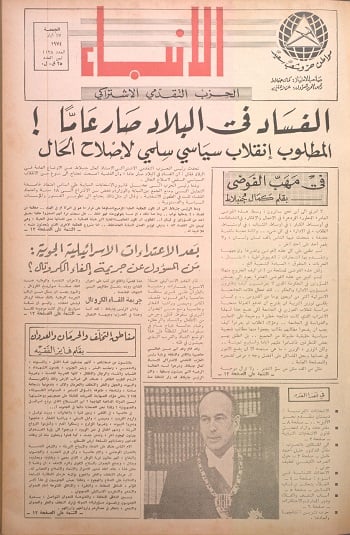We Need a Complete Nuclear-Weapons Ban
17 يناير 2018

On Saturday morning, people in Hawaii awoke to emergency alerts on their phones. ballistic missile threat inbound to hawaii. seek immediate shelter. this is not a drill.
There was no incoming missile. But it took the authorities 38 minutes to send another message alerting people that it was a false alarm. Before that, people were relying on Twitter for information. Some hid in their bathrooms, some went to public spaces, others just huddled where they were. Families called each other to say goodbye.
Those 38 minutes of terror reflect only a tiny fraction of the emotional trauma caused by nuclear weapons. These weapons have a legacy of anguish, pain, and suffering. From the horror experienced by the citizens of Hiroshima and Nagasaki in 1945, to the torment of those whose lands and waters nuclear weapons were tested upon in the ensuing decades, to the fear of the entire world held in the grip of possible nuclear annihilation, these weapons have scarred our global community. They will scar us further if we allow this situation to continue—until they kill us.
The sentiment expressed by many Hawaiians in the days following was that they had no idea where to go or what to do. They were not prepared for nuclear war. How could they be? There really is no way to prepare for a nuclear blast, nor for the radioactive fallout. Shelters, iodine pills, or duck-and-cover routines can only get you so far. If multiple nuclear weapons are exchanged, all of the preparation could can dream of would not be sufficient.
We are also not emotionally prepared. From the 1950s to the ’80s, the threat of nuclear war was part of our cultural experience. Films, books, and television programs exposed the risks and the possible consequences of the nuclear arms race. Activism against the bomb was at an all-time high: In 1982, 1 million people marched in Central Park to demand nuclear disarmament. Today, most people rarely think about nuclear weapons. With “fire and fury” back in the headlines, this may be changing, but we are still largely in collective denial about the risks.
We have been taught that these weapons are not meant to be used. We are taught that they protect us from conflict, war, and further nuclear proliferation. This lethal myth is based on the premise that in order to maintain international peace and security, we need certain countries to wield the capacity to slaughter civilians, incinerate cities, and destroy the entire planet. We believe that nuclear war will never happen, that nuclear weapons prevent it.
But many of us—including the majority of the world’s governments—understand that the only way to prevent nuclear war is to eliminate nuclear weapons. The alert in Hawaii could have prompted a nuclear war. So could a tweet from a president with a bruised ego. And so could any number of things. As then–UN Secretary General Ban Ki-moon said in 2013, “There are no right hands for wrong weapons.”
It is in this spirit that 122 governments voted to adopt a treaty prohibiting nuclear weapons on July 7, 2017. While the nuclear-armed states currently oppose it, this treaty offers an alternative to nuclear war.
It prohibits the use, threat of use, and possession of nuclear weapons, and sets out a process by which states with such weapons can join and eliminate their arsenals. Significantly, it recognizes that any use of nuclear weapons would be contrary to international humanitarian law. It puts nuclear weapons on the same legal footing as the other weapons of mass destruction (biological and chemical). The treaty makes no attempt to justify the possession or use of these weapons and makes no arguments in favor of deterrence doctrines. Nuclear weapons have been granted an exception for far too long. The 1970 Treaty on the Non-Proliferation of Nuclear Weapons was supposed to lead to disarmament: The nuclear-armed states agreed to eliminate their arsenals in exchange for the rest of the world agreeing never to develop them. But while proliferation has been limited, the nuclear-armed have failed to deliver on their disarmament commitments. Some have reduced the size of their arsenals only to invest billions of dollars into modernizing them. The Treaty on the Prohibition of Nuclear Weapons takes a new approach: outlawing these weapons for everyone, under all circumstances.
What happened in Hawaii should spur us to action to eliminate this threat once and for all. We must not wait for a real incoming missile to blast apart a beloved city, to incinerate our—or anyone else’s—families and friends. We should use this moment as a wake-up call.
Disarmament will not be easy. But what is more of a hassle: engaging in the work of eliminating nuclear weapons, or losing entire cities, continents, the planet?
 عن أمل جنبلاط المتجدد: لبنان يستحق النضال
عن أمل جنبلاط المتجدد: لبنان يستحق النضال
 صحافيون أم عرّافون!
صحافيون أم عرّافون!
 ماذا يجري داخل أروقة بيت الكتائب المركزي؟
ماذا يجري داخل أروقة بيت الكتائب المركزي؟


 عن الخرائط التي تُرسم والإتفاقات التي تتساقط!
عن الخرائط التي تُرسم والإتفاقات التي تتساقط!
 “الإنحراف في الحياة”/ بقلم كمال جنبلاط
“الإنحراف في الحياة”/ بقلم كمال جنبلاط
 هاشتاغ #صار_الوقت يحل أولاً في حلقة جنبلاط
هاشتاغ #صار_الوقت يحل أولاً في حلقة جنبلاط
 طاولة نقاش عن أزمة الصحافة في جامعة AUST
طاولة نقاش عن أزمة الصحافة في جامعة AUST
 عبدالله: ليظهر لنا وزير مكافحة الفساد حرصه في صفقات البواخر والفيول
عبدالله: ليظهر لنا وزير مكافحة الفساد حرصه في صفقات البواخر والفيول
 عبدالله: غريب أمر وزارة مكافحة الفساد!
عبدالله: غريب أمر وزارة مكافحة الفساد!

 Comment to Uri Avnery: How Sad What Is Looming Ahead
Comment to Uri Avnery: How Sad What Is Looming Ahead
 “Not Enough!”
“Not Enough!”
 … لمن لم يقرأ يوسف البعيني/ بقلم وسام شيّا
… لمن لم يقرأ يوسف البعيني/ بقلم وسام شيّا
 كمال جنبلاط في مولده الأول بعد المائة: تعاليمه وأفكاره ما زالت الحلّ/بقلم عزيز المتني
كمال جنبلاط في مولده الأول بعد المائة: تعاليمه وأفكاره ما زالت الحلّ/بقلم عزيز المتني
 رئيس حزب/ وليس (… سابقاً)/ بقلم د. خليل احمد خليل
رئيس حزب/ وليس (… سابقاً)/ بقلم د. خليل احمد خليل
 التوازن السياسي في لبنان
التوازن السياسي في لبنان
 لبنان… مشاريع انقلابية مؤجلة
لبنان… مشاريع انقلابية مؤجلة
 جنبلاط وحَمَلة أختام الكاوتشوك
جنبلاط وحَمَلة أختام الكاوتشوك
 Le Liban est un symbole de tolérance
Le Liban est un symbole de tolérance
 Our Automated Future
Our Automated Future
 The True Origins of ISIS
The True Origins of ISIS
 Les Misérables vs. Macron
Les Misérables vs. Macron
 عذراً أيها المعلم/ بقلم مهج شعبان
عذراً أيها المعلم/ بقلم مهج شعبان
 رساله الى المعلم / بقلم ابو عاصم
رساله الى المعلم / بقلم ابو عاصم
 إلى روح القائد والمعلم كمال جنبلاط/ بقلم أنور الدبيسي
إلى روح القائد والمعلم كمال جنبلاط/ بقلم أنور الدبيسي
 أسرار وعناوين الصحف ليوم الجمعة 14 كانون الاول 2018
أسرار وعناوين الصحف ليوم الجمعة 14 كانون الاول 2018














